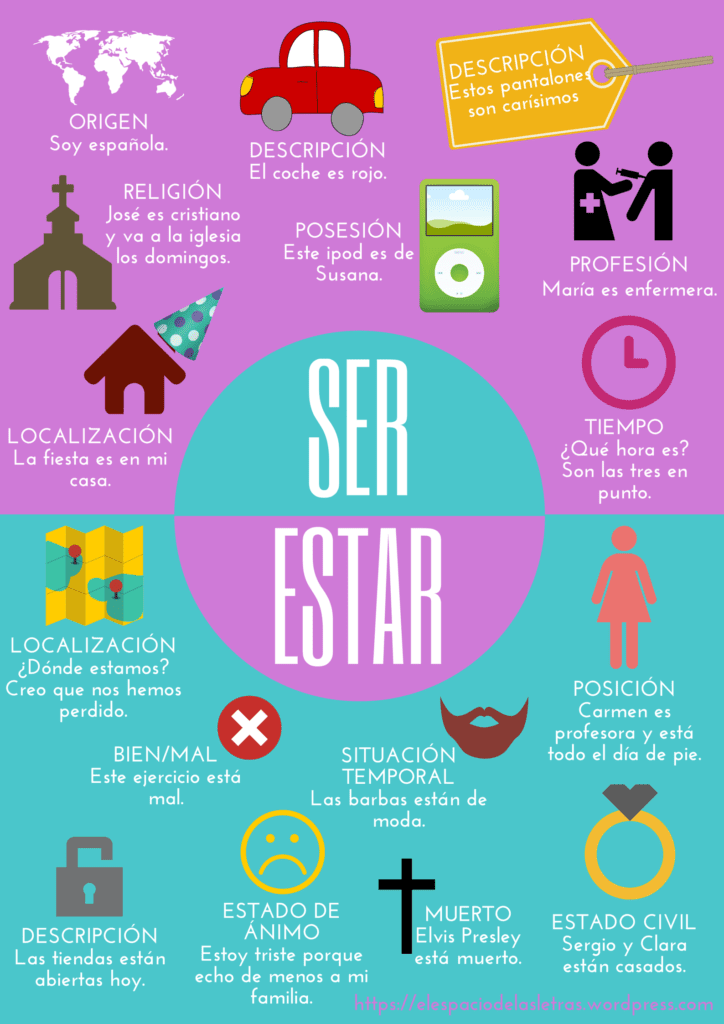Ser and estar can be a complicated topic for many Spanish language learners. In fact, many people have written extensive essays on the topic. This will be the subject of our discussion in this grammar blog and you will soon have a great understanding of the slightly confusing topic.
Start your Online Spanish Classes Today
The English translation of ser and estar is “to be”. Below is the conjugation of the verb “to be” in English:
to be
- I am
- you are
- he/she is
- we are
- you are
- they are
Look at this. Below is an example of a sentence that in English actually has two different meanings.
- The apple is green. – indicating that the apple is unripe
- The apple is green. – indicating the color of the apple
The first sentence talks about the condition of the apples, referring to the state or “ripeness” of the apple. The apple has that green color because it is not yet ripe, or ready to eat. When the apple turns red, that means that the apple is ready to eat.
- Can I eat the apple?
- No, it is unripe. (referring to the condition of the apple)
In the second example we are talking about the color, or physical appearance and characteristics of the apple. This apple is green when it is ready to eat, even after it ripens. In English, we use the verb “to be” to talk about the condition of something and the essence.
- What color is the apple?
- It is green (referring to the state of the apple).
In Spanish, two different verbs exist to express “to be” depending on what the speaker wants to express. Estar expresses the condition of something, or temporary states and locations. The verb ser expresses permanent or lasting attributes.
- La manzana está verde. – The apple is green. (unripe – state)
- La manzana es verde. – The apple is green. (color – lasting attribute)
Looking for a Spanish Teacher in Buenos Aires?
When we talk about condition or a state, we use the verb estar. Estar is an irregular verb meaning that it does not follow the normal rules of conjugation for -ar verbs. Therefore, you must memorize it’s forms:
estar
- yo estoy
- vos estás
- él/ ella/ usted está
- nosotros/ nosotras estamos
- ustedes están
- ellos/ ellas están
To talk about lasting attributes or essential qualities, we use the verb ser. Ser is also irregular and must be memorized.
ser
- yo soy
- vos sos
- él / ella/ usted es
- nosotros/ nosotras somos
- ustedes son
- ellos/ ellas son
If you are talking about what something is, use ser; if you are talking about how something is, use estar.
“What is he like?”
“He is anxious.”
Use ser: Él es ansioso (all the time, generally, it’s part of his personality)
“How is he feeling?”
“He is anxious.”
Use estar: Él está ansioso (right now because of a particular situation)


So let’s review:
Ser is used to express:
| date, time and day | Hoy es miércoles, ocho de enero. Es la una del mediodía. |
| place of origin/ nationality | Él es de Cuba. Este chocolate es swiso. |
| ocuppation | Ella es médica y su hija es estudiante. |
| religious or political affiliation | Barack Obama es demócrata. Mi familia es judía. |
| material that makes up something | La mesa es de madera de pino. |
| possession | El celular es de Miguel. |
| relationship of one person to another | Miguel es mi hermano. |
| essential qualities | El cielo es celeste. |
Estar is used to express:
| georgraphic or physical location | Las cataratas del Iguazú están en Misiones. Yo estoy en mi casa. |
| state or condition | Las empanadas están ricas. |
| idiomatic expressions | Estoy al día con la tarea. |
| progressive tenses | Ellos están comiendo ahora. |
More Spanish Learning: Do you know about Saber vs Conocer?
- For more Spanish Grammar contact our Spanish School in Toronto or Buenos Aires and start your classes. If you are looking for Diplomaturas click here. If you are looking for profesores nativos de ingles click here.




